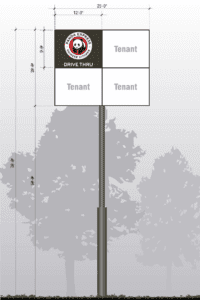 The Reno Planning Commission unanimously denied a request to build a 70-foot-tall sign facing U.S. 395 which is twice as tall as what the city permits. The public hearing June 8 included a request for a second 40-foot sign to face Sky Vista Parkway, which was also denied.
The Reno Planning Commission unanimously denied a request to build a 70-foot-tall sign facing U.S. 395 which is twice as tall as what the city permits. The public hearing June 8 included a request for a second 40-foot sign to face Sky Vista Parkway, which was also denied.
The request for a variance from the city’s sign code was submitted on behalf of a local restaurant franchise, Panda Express, for a development of vacant property wedged between Sky Vista and U.S. 395 in the north valleys. The applicant wanted a sign to face each roadway. The proposed signs were extremely large at 500 square feet each, which is double what the city allows. Under the city’s sign code, the development would only be allowed one 35-foot pole sign at a maximum 250 square feet in size, according to the planning staff report.
City staff recommended denial of the variance request. The planning commission decision is final unless appealed to the Reno City council.
Scenic Nevada was opposed to the variance for many of the reasons cited in the staff report and said so at the June 8 hearing. The signs were too big, too tall, didn’t fit with the surrounding development, were unnecessary and would mar the scenic views from the roadways. To gain approval, the applicants had to show a hardship – some extraordinary or exceptional difficulty with the property that would cause a need for more or bigger signs.
The applicant said at the public hearing that the hardship is a bend along U.S. 395 at the Lemmon Drive exit that would prevent drivers from seeing the restaurant in time to exit the freeway. The proposed 70-foot-tall multi-tenant sign would allow drivers to exit in a safe manner, according to the applicant. There was no reason given for requesting the second, 40-foot sign variance.
In its report city staff said neither the curve in the road along the freeway nor the vacant site along Sky Vista Parkway created undue hardship.
“There are no extraordinary physical characteristics to the property as this site is a relatively large, generally flat area which is highly visible from adjacent arterial roads,” the report said. “There is no exceptional undue hardship or practical difficulty based on the curvature of the highway, because the highway is not a street frontage for on-premises signs and the code has standards implemented to minimize visual pollution from these corridors.”
Staff also noted in its report that the signs would be taller than any others in the area and the Panda Express sign would be the only one within a mile facing the freeway. By comparison, the existing Walmart center sign near Sky Vista Parkway is 215 square feet and 35-feet tall. Further, staff said the proposal is inconsistent with the city’s Master Plan and the design of the sign “is not in harmony with the aesthetic or identity of the proposed development.”
Upholding the sign code was the right thing to do. Allowing variances in circumstances such as these would do away with sign codes designed to protect the quality of life in our community. Many thanks to planning commissioners and those who took the time to register their complaints about the proposal.
To support our continued efforts to preserve the scenic beauty of our state, as well as fighting billboard proliferation, please donate to Scenic Nevada today.